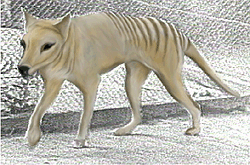Tasmanian Tiger
The Tasmanian tiger, or thylacine, was a shy, elusive creature hunted to extinction after only a century of European settlement in Australia. The last known animal died in a Hobart zoo over sixty years ago, ironically just a few months after it had been declared a protected species.
What did it look like?
|
The thylacine’s scientific name, Thylacinus cynocephalus, means pouched dog with a wolf’s head. However, it was a marsupial, not a dog. It had a thick, kangaroo-like tail, a large rear-opening pouch, and 13 to 19 dark brown stripes that extended from the base of the tail almost to the shoulders. Adults weighed from 15-30kg, and stood about 58cm (2′) high at the shoulder. Thylacines ate birds, and small animals like wallabies and kangaroos. After European settlement they were outlawed because they started to attack sheep and poultry, and a bounty of one pound was put on each of their heads. |
|
Is extinction forever? Although it is presumed extinct, the Tasmanian tiger has captured the imagination of the public. Expeditions and searches are still being mounted to find the animal in the wild, and there have been hundreds of reported sightings. Many people still hope that somehow the animals have survived in remote areas of Tasmania, and that one day they will see a thylacine. These people may have their wish granted, but not in the way they’ve been expecting. Scientists like Professor Michael Archer are becoming increasingly excited about the possibility of using DNA from preserved specimens to clone a thylacine. There is ample genetic material available to work with – apart from a young animal preserved in ethyl alcohol in the Australian Museum, specimens are also held in the Hobart Museum, the British Museum and the Smithsonian Institution. Not long ago this sort of procedure would have been considered impossible. However, technological advances (including the cloning of Dolly the sheep) have been so great in recent years, the idea of recreating a thylacine population could soon be a reality. Geneticists think that they may be able to accomplish such a feat within ten years. Professor Archer is convinced that bringing the thylacine back is the right thing to do, in fact he sees it as a moral imperative. Contact information Australian Museum, 6 College Street, Sydney, NSW, 2000. Phone: (02) 9320 6000, http://www.austmus.gov.au/thylacine |



